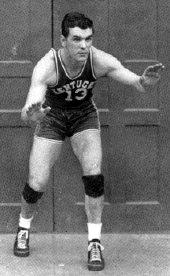![]()
![]()
 # 13
# 13
Hometown: Dayton, KY (High)
Position: C Playing Height: 6-0 Playing Weight: 170
Date of Birth: May 5, 1914
Date of Death: March 14, 1980
Nickname: Robert Davis "Twenty Grand" (More)
Additional Photos: (1) (2)
Game by Game Statistics
Kentucky Career Notes:
Multi-Sport Player [Football, Track]
Post-UK Career Notes: ![]() Professional Football Statistics [External Link]
Professional Football Statistics [External Link]![]()
| Season | Games Played | FG | FT | Total Points |
|---|---|---|---|---|
| 1935-36 | 1 | 0 | 1 | 1 |
| 1936-37 | 11 | 5 | 0 | 10 |
| 1937-38 | 3 | 2 | 0 | 4 |
| Total | 15 | 7 | 1 | 15 |
![]()
Other - Remember Twenty Grand?, Louisville Courier-Journal (March 21, 1980) by Earl Cox
The man John Wooden called the best athlete he ever saw or coached, Bob "Twenty Grand" Davis, one of the top halfbacks in University of Kentucky history, died in a nursing home near Cleveland on March 14 and was buried in Erlanger. He never recovered from a stroke suffered in January. He was 65.
Davis played everything for Dayton (Ky.) High, which is where Wooden coached him. His nickname, of course, came from the 1931 Kentucky Derby winner and one of his UK teammates, Bert Johnson, was called "Man o' War." In addition to football, Davis lettered one year in basketball for Adolph Rupp. I guess that made him the only person ever to play for both Rupp and Wooden. He also ran track at UK. While in high school, he won an Ohio amateur boxing championship. He played nine years in the National Football League.
Biography - Lexington Herald (March 29, 1980)
Days of College Heroes Were Fun AND Inexpensive
Take time, if you will, for a jog down memory lane.
It's a beautiful autumn day, Oct. 16, 1937, and you're a schoolboy watching your first University of Kentucky football game.
The scene is Stoll Field, the foe is Washington and Lee - not a national ranker but a team with a winning record thus far.
UK has scored, but W&L is driving. On the Wildcat 20-yard line, the drive falters. On fourth down the enemy resorts to passing, Big mistake.
As the pass spirals toward a receiver waiting in the end zone, a UK back leaps upward from his goal line to intercept.
It's Bob Davis, your hero.
He zigs once, zags once, and 10-plus seconds later crosses the W&L goal line for the first of five touchdowns he scores that day in UK's 41-6 rout of W&L.
The picture of that day and that interception came to mind recently on learning that our hero, Bob "Twenty Grand" Davis is dead at age 65. He suffered a stroke early this year, died March 14 in Cleveland and was buried in Erlanger.
In reporting on Davis' death, former Herald sportswriter Earl Cox, who now toils in Louisville, says Davis might have been the only athlete to play for both John Wooden and Adolph Rupp. Wooden coached Davis in high school at Dayton, Ky., and the all-around athlete played one year for Rupp in basketball at UK.
Russell Rice, former Leader sports editor, called Davis part of UK's "thoroughbred connection" in his remarkable book, The Wildcats, Kentucky Football.
Davis was nicknamed "Twenty Grand" after the speedy Derby winner of 1931. One of his backfield mates was Bert Johnson, known as "Man O' War".
Rice points out that Davis lettered at UK in 1935-36-37, and still holds the UK record for career points scored (180) and for touchdowns (30).
The memorable interception against W&L also has a place in the UK record book. It stood as the longest interception return (100 yards) until Dave Hunter tied it in 1968 against West Virginia.
The victory over Washington and Lee was doubly encouraging for UK fans, because another Kentuckian, Walter Hodge, from Paris, took the opening kickoff and ran 90 yards up the middle for a touchdown.
Hodge, a two-sports man in basketball and football, also died recently.
Davis also has as a teammate his brother, Dameron.
Twenty Grand started his varsity career (freshmen didn't play varsity ball in those days) in 1935 by scoring four touchdowns.
His five-TD effort against W&L in 1937 came on runs of 80, 50, 22 and 60 yards, in addition to the interception. It was the second time he had scored five touchdowns in one game.
What was a super runner doing intercepting a pass? Those were the days of one-platoon football, and 60-minute men weren't unusual.
About 11,000 fans were on hand that October day in 1937. Many of them were schoolboys and girls taking advantage of what was billed as the first "high school day" at Stoll Field.
In order to promote attendance and encourage youngsters to attend UK when they got out of high school, the university let them in for a quarter (that's right, 25 cents).
There was a bonus, too. High schoolers got a program free with the admission price.
So you see, reliving memories has another advantage. It's a way to beat double-digit inflation.
![]()